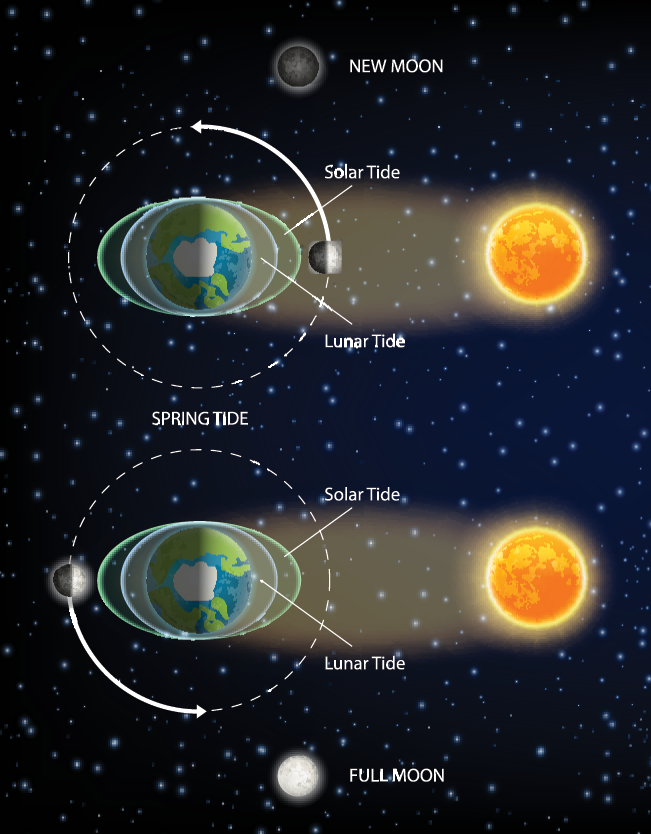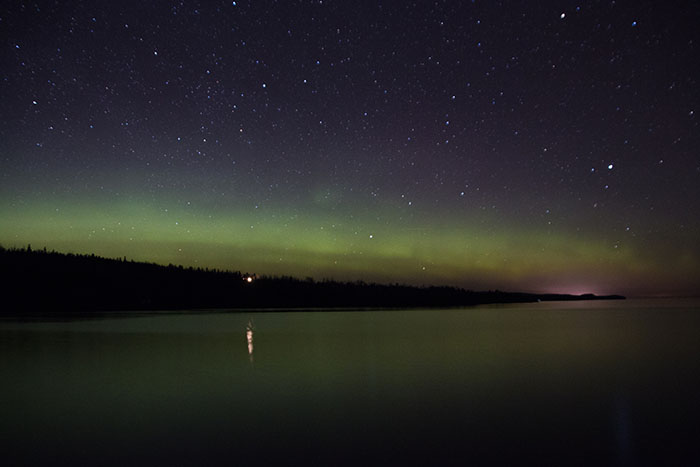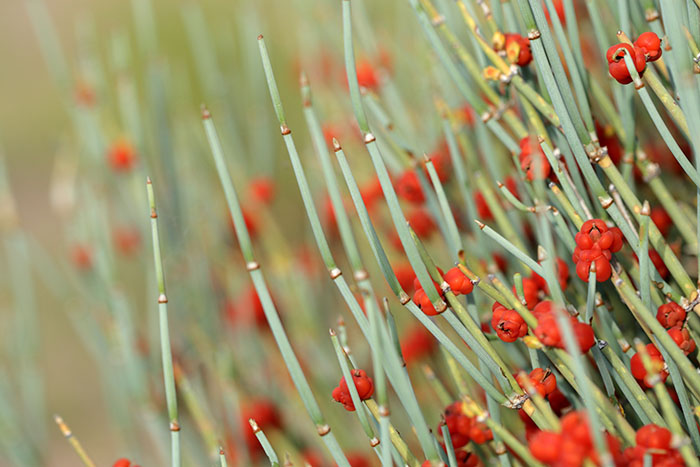As very young children we are taught to love the man in the moon. As a boy I owned a red telescope and there was something deeply mysterious about focusing in on distant lunar craters. The moon has been an important overseer of human evolution and was worshipped for centuries; the ancient Greeks named her Selene and the ancient Egyptians named him Khonsu. In terms of lunar influences on human activity, those engaged in forestry and agriculture have always had a connection with the moon’s phases. It is believed by some gardeners that the moon influences the growth of plants through its rhythmical rise and fall across the sky and journey from dark to light (waxing) and back again (waning). Is this belief simply a romantic spiritual idea or could there be more to it?
Gravity and Moon Planting Beliefs
We know that as the moon circles the earth (rather imperfectly in an oval shape) its gravity pulls on our enormous seas and oceans to create tides twice a day. The sun also plays its part with a tidal influence almost half that of the moon and, for much of the time, the sun counteracts the moon’s own gravitational pull. Ocean tides peak during a new moon (dark moon) when the sun and the moon are in alignment with the earth on the same side and combine gravitational forces in the same direction. During a full moon (brightest moon) the sun and moon are aligned in opposition to each other but the moon still creates a spring tide. The tidal bulge around the earth is not as strong during a full moon because of the sun counteracting the moon’s gravitational pull. A full moon is such a beautiful thing to behold, it looks powerful, but its gravitational pull is not as strong as a hidden new moon [1].

Lunar gardeners are often following the principles of bio-dynamics. They believe that the new and full moons pull on groundwater deep beneath the earth, causing moisture levels in garden or allotment soil to fluctuate at the surface. This gives rise to some basic lunar gardening principles.
- When the moon is furthest away from you (dark / new moon) its gravity pulls down and away from your garden and it’s a good time to:
- Fertilise beds, because that gravity will pull the nutrients deeper into the soil.
- Harvest root crops like potatoes because the soil is lighter and easier to lift from whilst the potatoes will contain more water.
- Tree pruning can be undertaken at this time because sap is being pulled downwards so there is less wound leakage and risk of infection.
- Those working in forestry have long believed that wood is best harvested from felled trees at this time (moon wood). During the reign of Louis XIV a royal forest order was passed stating that the felling of wood should occur during a waning moon between the falling of the leaves and the new growth season [2].
- As the moon’s phase starts to approach a full moon (waxing):
- Sow seeds because this will maximise available moisture at soil level.
- It will also be a good time to harvest ‘above ground’ crops when moisture and nutrients are being pulled upwards into the leaves to give a tastier crop (for example a cabbage or lettuce). Pliny the Elder advised Roman farmers to pick fruit for market just before the full moon as he believed it weighed more, but he recommended that fruit picked for storage should be harvested during the new moon, as it would last longer.
Some of these ancient ideas seem to make sense at a basic level and in the case of Pliny the Elder how would he have even thought to invent the idea without understanding the potential of gravity? Trial and error would seem a persuasive argument. However, if for example a new moon has pulled moisture down with more gravitational power than a full moon has available, how does a full moon manage to pull it all back up again later? These forces are not in balance with each other. If I was a plant I’d be pretty annoyed that I had just sucked up lots of water only for a new moon to suck it away again!
Moon gardeners should also factor in the moon’s closest passes to the earth (known as its perigee). A perigee distance during a full moon is called a super moon and even increases gravitational pull on a human being by 1/14th the mass of an ordinary paper clip [3]. During a new moon the gravitational effect of a perigee event would be 44% greater than during a super moon. On August 30th 2019 there will be a perigee new moon event – does that mean we should be fertilising our soil on August 28th and 29th for extra deep root feeding or lifting up root crops for maximum size?
Water: Oceans, Lakes and Tides
Whilst the moon does influence the oceans to create noticeable tides it hardly influences smaller bodies of water on land such as ponds. Lake Superior in North America is by volume, the third-largest freshwater lake in the world but the 11,600km3 of water it contains are only enough to give it a tide of around 2cm during a full moon! [4] How could we expect the moon to have any impact on a few millimetres of soil moisture on an allotment?

Oceans are a part of a huge body of water which is in a continual state of global flux. Much of the movement is caused by existing gravitational water displacement. This means that if the moon instantly vanished there would still be some tides on Earth for a short time whilst the water sloshed backwards and forwards across the planet (a bit like when you slide up and down inside a full bathtub and the water continues to move even when you stop). We cannot look at the strength of the moon’s gravitational pull on our seas and extrapolate the same level of impact on land based soil moisture.
Furthermore, groundwater is held in place by the pressure of the rocks and sediment. It cannot easily move vertically through these in the same way that seawater can slide about freely at the surface. Imagine that you filled that same example bathtub with water again and placed a huge sponge inside to absorb it all – no amount of bath tipping would cause matching water displacement out of the sponge. Sediment and rock is much like that sponge and inhibits any influence the moon’s gravitational pull might have on groundwater.
Lunar Gravity and Trees
If the moon’s gravity affects plants it’s most likely to do so when it peaks during a new moon. I just might believe that a very large tree could be effected by the downward pull of the sun and moon together in a new moon alignment since a tree consists of a larger vertical ‘body’ of water. In trials during 1998 tree biologist and anatomist Ernst Zürcher (of the Swiss Federal Institute of Technology in Zurich) found that when the moon’s pull was strongest, seedling trees were 5 to 10 micrometers narrower than when it was at its weakest [5]. The scientists thought that changes in the moon’s pull may somehow drive the water from the cytoplasm into the cell walls and then back again, causing the subtle swelling and shrinking. So there would seem to be something there, but science has not yet pinned it down.

What about Lunar Geotropism?
Geotropism says that a seed can detect up from down because of the force of the earth’s gravity. Take a tulip bulb and plant it on its side and the shoot will still find its way upwards whilst the roots find their way downwards. It is unlikely that the gravitational force of the moon has any impact on plant geotropism, the earth’s own gravity is too powerful and we don’t see roots being disturbed by a new moon. It’s interesting to note that in experiments aboard the International Space Station (ISS) plants that were grown in a zero gravity environment still grew as expected [6]. Astronauts found that shoots still grew out from a seed in the opposite direction to roots even when there is not a gravitational force at work. Gravity is a guide for plants, but neither inhibits or promotes growth – which rules out any lunar effect on geotropism.
[hr gap=”5″]Moonlight and Plant Growth? Lunisolar Influence
Moonlight originally comes from the sun and is reflected back to earth. This doesn’t seem to stop vampires from moving about after dark so it can’t be very strong at all compared to sunlight can it? In all seriousness it isn’t. Sunlight is 400,000 times brighter than the light reflected by a full moon [7]. If a solar panel generates 200 watts per square meter when the sun is overhead, it will only generate 0.5 milliwatts when a full moon is overhead. There’s energy there, but a lot less of it.
Moonlight is ‘redder’ than sunlight. This is because the moon is not a mirror, instead the moon is largely made of igneous rock which has its own unique colour spectrum that it produces when reflecting sunlight. Most sunlight (86.4%) is absorbed by the moon and that means it doesn’t reflect all wavelengths evenly, it reddens the spectrum. So moonlight is a slightly redder and tiny source of light / energy, could it be of any use to plants or life on earth? Possibly.

On the Great Barrier Reef corals only reproduce en-masse during a full moon, this is not because of gravity but because of moonlight – if it’s cloudy they often do not spawn [8]. Clearly they have developed the ability to recognise the unique red spectrum of moonlight as an indicator of a high tide. Of course the moon is not the only cue the corals use; water temperature and day length are also a factor. Whilst corals are not plants they give us a sign that life on earth can evolve to detect moonlight.
There’s a herb that lives on the cliffs of Italy called Ephedra which only releases pollen on a full moon. Scientists have researched this, and verified it [9]. It is believed that it does this because insect numbers should be higher during a full moon when insects would find it easier to navigate. Thus it increases the chances of pollination. Whilst this seems to go against the prevailing theory that most insects are less active on a full moon, that finding was based upon fewer of them getting caught in light traps (which is obvious if they are competing with moonlight). It is likely that as with coral, Ephedra has evolved to detect the particular red spectrum of light given off by a full moon.

In 2015 a newly discovered family of plant genes was found which acts as a plant’s daily alarm, triggering a growth spurt just before dawn. The timing of the growth spurt is known to be choreographed by the plant’s circadian clock, which is reset by changes in light at dawn and dusk [10]. The clock dictates when most physiological processes, such as the uptake of water and the breakdown of starch, happen throughout the day. Could it be possible that the light of a full moon influences the circadian rhythm of plants? Other controlled experiments have linked moonlight exposure to increased starch breakdown in leaves [11]. Conversely in the 17th century it was observed that plants continued to open and close their leaves when kept in the dark and out of sunlight, as if they had an internal body clock, possibly based upon lunar gravity.
[hr gap=”5″]In Summary

It seems that there are many factors that contribute towards plant growth, from weather and water to temperature, gravity, sunlight and moonlight. Over millions of years plants have evolved to react to a number of hidden signals to enhance their growth potential. Whilst moon magic might still sound like ancient witchcraft there are modern proponents of moon gardening that swear by its many benefits, Charles Dowding for example. I think it would be very foolish to rule out the influence of the moon’s phases, in particular the power of a new moon, especially at perigee. Be it moonlight or gravity the moon could be more of an influence than we know. This year I fully intend to sow pumpkins 14 days prior to a full moon to maximise the upward lift of full moon gravity exposures during the plant’s life cycle. For potatoes I shall plant them 14 days prior to a new moon to maximise water storage cycles within tubers. In the case of garlic I think it will be best to harvest bulbs during a new moon and I’ll do my best to follow Pliny the Elder and harvest fruit from trees on a full moon. Other plot holders might think I’m barking, fingers crossed I don’t turn into a werewolf.
[hr gap=”5″]“Tha Moon Is Very Useful Everyone” (one of my favourite moon songs)
References
1. Eylene Pirez, Astrophysicist – Full Moon vs New Moon Tides
2. How Plants Work – Lunar Rhythsm in Forestry Traditions
3. EarthSky – 1/14th the mass of an ordinary paper clip
4. Science Focus – What size does a body of water have to be to be influenced by the Moon’s gravity?
5. Science Magazine – Changes in the moon’s pull may somehow drive the water from the cytoplasm into the cell walls and then back again, causing the subtle swelling and shrinking.
6. National Geographic – Plants Grow Fine Without Gravity
7. Discover Magazine – The Sun is 400,000 times brighter than the full Moon
8. National Geographic – Plants Grow Fine Without Gravity
9. Science Magazine – Plant releases its pollen in the full moon
10. New Scientist Magazine – Plants’ daily alarm clock discovered
11. Nature Journal – Chemical Effects of Moonlight (1947)



